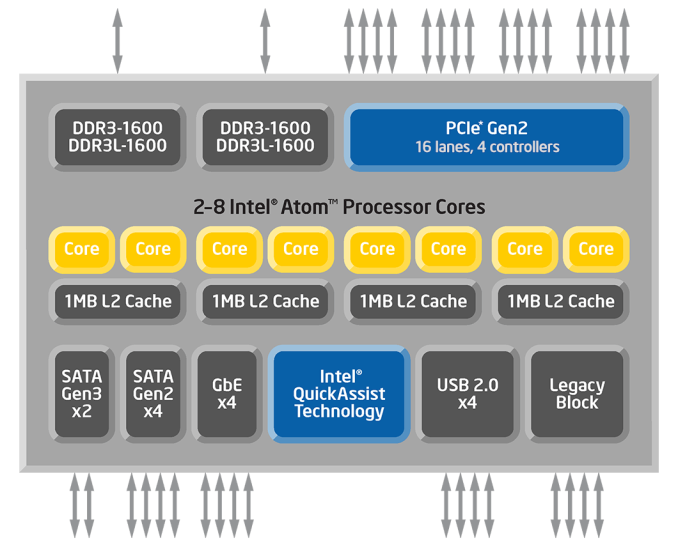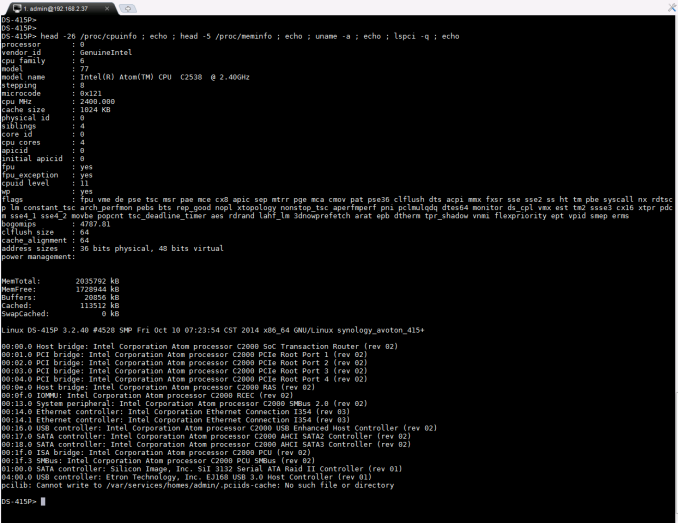Synology DS415+ Review: DSM on Intel Rangeley
by Ganesh T S on October 30, 2014 7:30 AM EST- Posted in
- NAS
- Storage
- Intel
- Synology
- Silvermont
- Enterprise
- Rangeley
Platform Analysis
The higher end segment of the SOHO / SMB NAS market uses Intel's Core-series and Xeon CPUs to deliver the required performance while supporting a large number of drive bays (typically more than 8, in a rackmount form-factor). Over the last four years or so, Intel's play in the other tiers has been mainly with its Atom CPU lineup. Back in 2010, Intel pushed the 45 nm Atom D410 / D510 / D525 for NAS units. In 2012, it was the 32 nm Atoms, the D2550 and D2700. All of these were based on the in-order Bonnell microarchitecture which was fast becoming dated compared to the advancements being made by the ARM SoC vendors. In moving from 32nm to 22nm, Intel completely revamped the microarchitecture for their Atom cores. Bonnell was replaced by Silvermont, bringing out of order execution and other improvements into the picture. Silvermont's applicability to a variety of power profiles meant that there were multiple product lines that ended up using the CPU cores. Bay Trail is proving very effective in tablets and also makes up QNAP's TS-x51 and TS-x53 Pro NAS series. Merrifield and Moorefield are trying to break into smartphones, but it is Avoton and Rangeley that are more relevant to the storage appliances market.
The different product lines integrated different I/O around the Silvermont cores depending on the target market. Avoton is meant for microservers and cloud storage platforms, while Rangeley is meant for communication and network infrastructure. Both of them integrate similar I/O around the cores, but the Rangeley parts have an updated crypto engine. The block diagram of a generic Rangeley part is provided below.
There is a wealth of I/O (2x SATA Gen 3, 4x SATA Gen 2 and up to 16 PCIe 2.0 lanes) for the storage subsystem, and the parts also support up to 4x 2.5 Gbps network links. From the viewpoint of the Synology DS415+, the above block diagram should be considered in the context of the information gleaned via SSH access to the unit.
The DS415+ uses the Intel Atom C2538 SoC which has four Silvermont cores running at 2.4 GHz. It is backed up by 2 GB of DRAM. The Atom C2538 has 16 PCIe 2.0 lanes across four controllers. The Silicon Image SiI3132 PCIe to 2-port SATA II host controller uses a single PCIe 2.0 lane on the host side. The device side can support port multipliers. Synology indicates that the eSATA port on the DS415+ can be used to connection an expansion chassis. However, unlike the scalable series, the external chassis can't be used to expand existing volumes in the main unit. The other chip connected to the SoC via PCIe is the Etron EJ168 USB 3.0 host controller. It also uses a single PCIe 2.0 lane on the host side and provides two USB 3.0 ports. These two enable the eSATA and the 2x USB 3.0 ports on the rear of the unit. The single USB 2.0 port in the front comes directly off the Atom C2538. Obviously, in a platform like Intel Rangeley, there is no need for SATA - PCIe bridges.
The more interesting aspect is the two Ethernet controllers. Unlike the Intel I211 GbE controllers in the Seagate NAS Pro 4-bay that we looked at earlier, the Synology DS415+ uses the Intel I354 2.5G Ethernet controllers. Despite being 2.5G-capable, Synology only advertises GbE links [Update: Synology clarified that even though the controllers are rated for 2.5Gbps, the transceivers they are linked to limit the rate to 1 Gbps]. Perhpaps, when the NBASE-T Alliance initiatives take off, we can get official 2.5Gbps ecosystem support from Synology as well as affordable and efficient peripherals. Current 10GBASE-T switches still need some updates to be more power efficient, and adoption is still not high enough to force pricing downwards.
On the software front, the DS415+ runs Linux (kernel version 3.2.4). We have covered DSM 5.0's setup and usage impressions in our recent DS214play and DS414j reviews. There is not much point in rehashing the same excellent setup and usage experience. That said, with the ioSafe 1513+, we also started looking at iSCSI support in NAS units. We will be looking at that aspect in this review also.












41 Comments
View All Comments
Arkive - Thursday, October 30, 2014 - link
Does this (or any NAS that you know of) support simultaneous access from both the USB port as well as over the network? I understand the "only one interface can control the storage at one time" issue, but I'm really hoping someone is working to overcome this, even if it means that one of those interfaces is locked into read-only mode.ganeshts - Thursday, October 30, 2014 - link
The USB ports are host ports, i.e, storage devices or WLAN USB sticks can be connected to it. The USB port can't be used to connect to a PC for using the unit as a DAS (direct-attached storage).rpg1966 - Thursday, October 30, 2014 - link
Seriously, articles with graphs showing two aspects of the same thing (e.g. rebuild times in this case) need to be shown on an X-Y chart, so that the trade-offs are immediately and obviously visible.The same goes for many similar pairs of charts you show in other reviews, e.g. power-vs-noise in GPU or case reviews.
echtogammut - Thursday, October 30, 2014 - link
I almost spat coffee all over my monitor when I saw the tertiary drive in the test rig. That is a very expensive way of eliminating the test rig as a performance bottleneck in the tests.Salipander - Thursday, October 30, 2014 - link
It's about time that transcoding includes h265 support, and be mentioned in reviews. This DS415+ unit may provide this for resolutions up to 1080p. This is for sure not supported by the DS415play, as it won't have the cpu power to do this in sw, but the DS415+ just may do it.I have quite a movie collection and I am halving the needed storage by transcoding the files from h264 to h265, including all the sub 4k files (which is 100% of them ;-) I may be an early h265 adopter, but the cpu intensive transcoding is worth the effort already. The x265 coder is of such a good quality now (since august at least), that I dare to go for it.
It would be nice to have the DS Video capability to transcode h265 to something suited for current tablets and media players!
DanNeely - Thursday, October 30, 2014 - link
Is the ram soldered to the PCB, or in a dimm that could be swapped out for an ECC module?skarnm2 - Thursday, October 30, 2014 - link
I did read elsewhere it was soldered. It is on the larger models it's swap-able.chubbypanda - Thursday, October 30, 2014 - link
Non-ECC and ECC modules aren't interchangeable. Do not attempt!mpbrede - Thursday, October 30, 2014 - link
Define COTS, please? Some form of "... Off The Shelf"ganeshts - Thursday, October 30, 2014 - link
Commercial :)I thought it was pretty common usage, and a cursory search online makes me think I may not have been mistaken: http://en.wikipedia.org/wiki/COTS